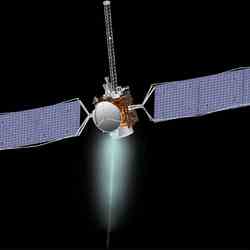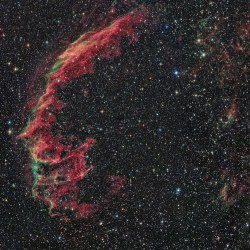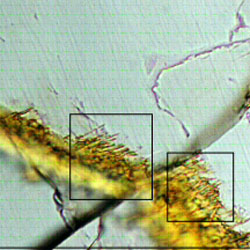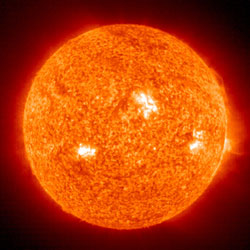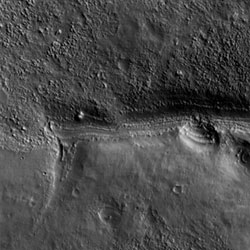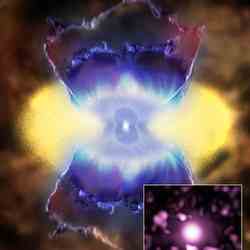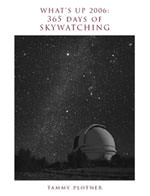
Download our free “What’s Up 2006” ebook, with entries like this for every day of the year.
|
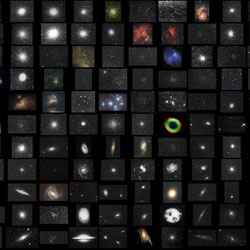
110 Messier Objets. Image credit: Hartmut Frommert – SEDS. Click to enlarge.
Greetings, fellow SkyWatchers! It’s that time of year again … Are you ready to run the Messier Marathon? If you’d rather take your stars at a more leisurely pace – then follow along as we spread 110 of the best sky objects out over the next week. Let’s hope for clear skies as we grab binoculars or telescopes and head out into the night, because…
Here’s what’s up!
Monday, March 27 – This is going to be one incredibly busy week as we start off the show with an occultation of Uranus by the Moon. Check with IOTA for more details.
As we open our week long tour known as a “Messier Marathon,” the late rise of the Moon tonight will be on the side of observers.
Beginning as soon as the sky darkens enough to find the guidestar Delta Cetus, the M77 spiral galaxy will be your first, and the M74 spiral galaxy east of Eta Pisces will be your second mark. Both of these galaxies are telescopic only and will be an extreme challenge at this time of year due to their low position. Even computer-assisted scopes will have some difficulty revealing this pair under less than optimal conditions. Next up is M33 west of Alpha Triangulum. With ideal skies, the “Pinwheel Galaxy” could be seen in binoculars, but skybright will make this huge, low surface brightness spiral difficult for even telescopes at low power. M31 – the Andromeda Galaxy – will, however, be a delightful capture for both binoculars and scopes just west of Nu Andromedae. For the telescope, two more on the list are companions to M31 – the elliptical M32 on the southeastern edge and M110 to the northwest.
Let’s head northwest as we take on two open clusters visible to both telescopes and binoculars. You can find M52 easiest by identifying Alpha and Beta Cassiopeia, drawing a mental line between them and extending it the same distance northwest of Beta. Next just hop north of Delta to pick up our ninth object – the M103 open cluster. Time to head south towards Perseus and go back to the telescope to locate M76, the “Little Dumbbell” planetary nebula, just north of Phi. Binoculars are all that’s needed to see the M34 open cluster also in Perseus, located roughly halfway between the “Demon Star” Algol and lovely double Almach, Gamma Andromeda.
Now that skies are dark and the fastest setting objects are out of the way, we can take a moment to breathe as we view M45 – the Pleiades. The “Seven Sisters” are easily visible to the unaided eye high in the west and their cool, blue beauty is incomparable in binoculars or telescopes. Our next “hop” is with the “rabbit” Lepus as we go back to the south and identify Beta and Epsilon. Triangulating with this pair to the south is a nearly fifth magnitude star (ADS 3954) which will help you locate the small globular M79 to its northeast. At around magnitude 8.5, it is possible to see its very tiny form in binoculars, but M42 – the “Great Orion Nebula” is much easier. The next object, M43, is part of the Orion Nebula, and you will catch it as a small “patch” to the north-northeast. The next two objects, M78 northeast of Zeta Orionis and the M1 Crab Nebula northwest of Zeta Tauri, are both achievable in binoculars with excellent conditions, but are far more interesting to the telescope.
Now we can really relax. Take a few minutes and grab a cup of coffee or hot chocolate and get warmed up. The remaining objects on our observing list for tonight are all very easy, very well positioned for early evening, and all observable in just binoculars. Are you ready? Then let’s go.
M35 is just as simple as finding the “toe” of Gemini – bright Eta. A short hop to the northwest will capture this fine open cluster. The next stop is Auriga and we’ll go directly between silicon star Theta and southern Beta. About halfway between them and slightly to the east you will find open cluster M37. This time let’s use Theta and Iota to its west. Roughly halfway between them and in the center of Auriga you will find M38 and a short hop southeast will capture M36. Now let’s get Sirius and finish this list for tonight. The open cluster M41 in Canis Major is found just as quickly as drifting south of the brightest star in the sky. The last three for tonight couldn’t be any easier – because we just studied them before. Go capture M93, M47 and M46 in Puppis… And give yourself a well-deserved pat on the back.
You’ve just conquered 24 Messiers.
Tuesday, March 28 – Ready for tonight’s challenge? Then nap away the very early evening hours and let’s head out well before bedtime to work on the next section of our week-long “marathon.”
First up will be four binocular targets, the incredibly colorful open cluster M50 is roughly a third of the way in a line drawn between Sirius and Procyon – use binoculars. Hydra is a difficult constellation, but try dropping south-southeast of the most eastern star in Monoceros – Zeta – about half a fist’s width to discover relatively dim open cluster M48. Far brighter, and usually visible to the unaided eye is M44, better known as the Beehive Cluster, just a scant few degrees north-northwest of Delta Cancri. From Delta, go south and identify Alpha because M67 is just to its west. It will appear as a “fine haze” to binoculars, but telescopes will find a spectacular “cloud” of similar magnitude resolvable stars.
Now we really do have to use the telescope again because we’re going “lion taming” by hunting galaxies in Leo. Let’s trade one Alpha for another as we head west to Regulus. Roughly about a fist width east of this major star you will see two dim stars that may require the use of the finderscope – 52 to the north and 53 to the south. We’re heading right between them. About a degree and a half south of 52, you will discover ninth magnitude elliptical M105. Larger scopes will also show two additional faint galaxies, NGC 3384 and NGC 3389 to M105’s west. Continuing about a degree south towards star 53 you will spot the silver-gray beauty of M96 in a relatively starless field. Enjoy its bright nucleus and wispy arms.
About another degree west will bring you to M95, which is neither as bright nor as large as its Messier “neighbor.” Small scopes should show a brightening towards its center and large ones should begin to resolve out the arms of this awesome barred spiral. Our next destination is the southwestern star of the three that mark Leo’s “hips,” Theta Leonis – or more commonly called Chort. South of it you will see faint star 73 and right around one degree to its east-southeast you will locate a pair. In small scopes at low power, M65 and M66 are same field. The western M65 and eastern M66 are both beautiful spirals.
Now let’s head north for another “same field pair” of galaxies and hunt down M81 and M82 in Ursa Major. Many folks have trouble “star hopping” to these galaxies, but a very simple way of finding them is to draw a mental line between Phecda (Gamma) and Dubhe (Alpha). By extending that line beyond Dubhe almost the same distance, you’ll locate our next two “marathon” objects. At low power with a smaller scope, the southern-most and most pronounced of the two is the stunning M81 with its bright core. To the north is broken, spindle-shaped peculiar galaxy M82. Viewable in binoculars, we’ll study more about this pair later on as we head for Mirak (Beta) and our next galaxy. About a degree and a half southeast you will see a 10th magnitude “scratch” of light. This great edge-on galaxy – M108 – should show at least four brighter “patches” to the small scope and a nice dark dust-lane to larger ones. Continuing about another half degree southeast will bring you to the planetary nebula M97. Also known as the “Owl,” this 12th magnitude beauty is roughly the same diameter as Jupiter and can be spotted under optimal conditions with binoculars – but requires a large scope at high power to begin to discern its features. Let’s continue south to Phecda and less than half a degree to the east you will locate M109. In the field with Gamma, M109 will show its faded central bar and prominent nucleus to the small scope, but requires large aperture and high magnification to make out structure. The last in Ursa Major is an error on Messier’s part. Labeled as M40, this object is actually double star WNC 4, located in the same eyepiece field as 70 Ursae Majoris to the northeast.
Now let’s move into Canes Venatici and round up a few more. This is an area of dimmer stars, but the two major stars, Alpha (it is called Cor Caroli and it is a wonderful double star) and Beta are easily recognizable to the east of the last star in the “handle” of the “Big Dipper” (Eta). The northernmost is Beta and you will find the soft-spoken spiral galaxy M106 almost midway between it and Phecda less than 2 degrees south of star 3. M94 is a much brighter, compact galaxy and is found by forming an isosceles triangle with Alpha and Beta Canum with the imaginary apex towards Eta Ursae Majoris. M63 is a very pretty, bright galaxy (often known as “the Sunflower”) that approaches magnitude 10 and is found about one-third the distance between Cor Caroli and Eta Ursae Majoris (Alkaid). Still heading towards Alkaid (Eta UM), the incomparable M51 comes next. Near Eta you will see an unmistakable visual star called 24 CnV, the “Whirlpool” is the same basic distance to the southwest. Now that we’re back into “big bear country” again, we might as well head on to the M101 “Pinwheel” galaxy which is found by following the same trajectory and distance to the other side of Alkaid. Before we head on, let’s continue north and clean up… ummm… another “messy mistake.” The accepted designation for M102 is lenticular galaxy NGC 5866, located in Draco south east of Iota.
Now let’s finish up – it’s getting late. Our next stop will be to identify the three primary stars of Coma Berenices now high in the east above Arcturus. You will find small globular cluster M53 northeast of Alpha. One of the coolest galaxies around is M64 (known as the “Blackeye”) just a degree east-northeast of 35 Comae, which is about one-third the distance between Alpha Comae and Alkaid. The last, and most outstanding for the night, is a globular cluster that can be seen in binoculars – M3. As strange as this may sound, you can find M3 easily by drawing a line between Cor Caroli and Arcturus. Starting at Arcturus, move up about one third the way until you see Beta Comae to the west of your “line”… Poof. There it is.
Awesome job. We’ve just completed another 24 objects and we’ve claimed 48 on the Messier list before bedtime in two days.
Wednesday, March 29 Born today in 1749, Pierre Laplace was the mathematician who invented the metric system and the nebular hypothesis for the origin of the solar system. Also born on this day in 1693 was James Bradley, an excellent astrometrist who discovered the aberration of starlight in 1729, as well as the nutation of the Earth. In 1802, Heinrich W. Olbers discovered the second asteroid, Pallas, in the constellation Virgo while making observations of the position of Ceres, which had only been discovered fifteen months earlier. Five years later on this same date in 1807, Vesta – the brightest asteroid – was discovered by Olbers in Virgo, making it the fourth such object found.
And if you thought this day was busy in history, then it’s about to get a whole lot busier as we add a total solar eclipse! While the path of totality is quite narrow, viewers across portions of Asia, Europe and North Africa will see the Sun partially eclipsed. Please check Fred Espenak’s Eclipse Home Page for precise times and locations… And check the web for live feeds of the event!
We have one more day until New Moon, but the challenge will not be so much avoiding Luna, or the visibility of the next objects – but the “window of opportunity” in which we’ll be able to see them. Am I going to ask you to stay up past your bedtime? Darn right…
These next targets will be best viewed after midnight when the constellations of Coma Berenices and Virgo have well risen, providing us with the darkest sky and best position. For the large telescope, we are going to be walking into an incredibly rich galaxy field that we will touch on only briefly because they will become the object of future studies. Just keep in mind that our Messier objects are by far the brightest of the many you will see in the field. For the smaller scope? Don’t despair. These are quite easy enough for you to see as well and probably far less confusing because there won’t be so many of them visible. Now let’s identify the easternmost star in Leo – Denebola – and head about a fist width due East…
Our first will be M98, just west of star 6 Comae. It will be a nice edge-on spiral galaxy in Coma Berenices. Next return to 6 Comae and go one degree southeast to capture M99, a face-on spiral known as the “Pinwheel” that can be seen in apertures as small as 4″. Return to 6 Comae and head two degrees northeast. You will pass two fifth magnitude stars that point the way to M100 – the largest appearing galaxy in the Coma/Virgo cluster. To the average scope, it will look like a dim globular cluster with a stellar nucleus. Now let’s continue on two degrees north where you will see bright yellow 11 Comae. One degree northeast is all it takes to catch the ninth magnitude, round M85. (Ignore that barred spiral. let’s keep moving…) Now, let’s try a “trick of the trade” to locate two more. Going back to 6 Comae, relocate M99 and turn off your drive. If you are accurately aligned to the equator, you may now take a break for 14 minutes. When you return the elongated form and near stellar nucleus of M88 will have “drifted” into view. Wait another two to three minutes and the faint barred spiral M91 will have joined the show in a one degree field of view? Pretty fun, huh?
Now let’s shift guidestars by locating bright Vindemiatrix (Epsilon Virginis) almost due east of Denebola. Let’s hop four and a half degrees west and a shade north of Epsilon to locate one of the largest elliptical galaxies presently known – M60. At a little brighter than magnitude 9, this galaxy could be spotted with binoculars. In the same telescopic low power field you will also note faint NGC 4647 which only appears to be interacting with M60. Also in the field is our next Messier, bright cored elliptical M59 to the west. (Yes, there’s more – but not tonight.) Moving a degree west of this group will bring you to our “galactic twin,” fainter M58. Moving about a degree north will call up face-on spiral M89, which will show a nice core region in most scopes. One half degree northeast is where you will find the delightful 9.5 magnitude M90 – whose dark dust lanes will show to larger scopes. Continue on one and a half degrees southwest for M87, one of the first radio sources discovered. This particular galaxy has shown evidence of containing a black hole and its elliptical form is surrounded by more than 4,000 globular clusters.
Just slightly more than a degree northwest is a same field pair, M84 and M86. Although large aperture scopes will see many more in the field, concentrate on the two bright cored ellipticals which are almost identical. M84 will drift out of the field first to the west and M86 is east. Next we will select a new guidestar by going to 31 Virginis to identify splendid variable R about a degree to its west. We then move two degrees northwest of R to gather in the evenly lighted oval of M49. Now shifting about three degrees southwest, you will see a handsome yellow double – 17 Virginis. Only one-half degree south is the large face-on spiral, M61. Larger scopes will see arms and dust lanes in this one. Last for tonight is to head for the bright blue beauty of Spica and go just slightly more than a fist width (11 degrees) due west. M104 – the “Sombrero” galaxy – will be your reward for a job well done.
Congratulations. You’ve just seen 17 of the finest galaxies in the Coma/Virgo region and our “Marathon” total for three days has now reached 65. We’re over halfway home…
Thursday, March 30 – Today celebrates the first flyby of Mercury by Mariner 10 in 1974.
Hey… It’s New Moon. While tonight would be the “perfect choice” for completing a Messier Marathon from start to finish, there are no iron-clad guarantees that the sky will cooperate on this date. Even worse? Many of us have to work the next day. So what’s an astronomer to do, eh? How about if we try an “early to bed and early to rise” attitude and conquer these next objects well ahead of the dawn? Set your alarm for 3:00 am, dress warm and let’s dance.
With Corvus relatively high to the south, the drop is about five degrees to the south-south east of Beta Corvi. Just visible to the unaided eye will be the marker star – the double A8612. Eighth magnitude M68 is a bright, compact globular cluster in Hydra that will appear as a “fuzzy star” to binoculars and a treat to the telescope. Our next is tough for far-northern observers, for the “Southern Pinwheel” – M83 – is close to ten degrees southeast of Gamma Hydrae. (This is why it is imperative to get up early enough to catch this constellation at its highest.)
Now we’re going to make a wide move across the sky and head southeast of brilliant Arcturus for Alpha Serpentis. About 8 degrees southwest you will find outstanding globular cluster M5 sharing the field with 5 Serpens. Now locate the “keystone” shape of Hercules and identify Eta in its northwest corner. About one-third of the way between it and Zeta to the south is the fantastic M13, also known as the “Great Hercules Globular Cluster.” A little more difficult to find is the small M92 because there are no stars to guide you. Try this trick – Using the two northernmost stars in the “keystone,” form an equilateral triangle in your mind with its imaginary apex to the north. Point your scope there. At sixth magnitude, this compact globular cluster has a distinct nucleus.
Now we’re off to enjoy summer favorites and future studies. M57, the “Ring Nebula,” is located about halfway between Sheilak and Sulafat. You’ll find the small globular M56 residing conveniently about midpoint between Sulafat and Alberio. About 2 degrees south of Gamma Cygni is the bright open cluster M29. And equally bright M39 lays a little less than a fist width to the northeast of Deneb. If you remember our hop north of Gamma Sagitta, you’ll easily find M27, the “Dumbbell Nebula,” and the loose globular, M71, just southwest of Gamma. All of the objects in this last paragraph are viewable with binoculars (albeit some are quite small) and all are spectacular in the telescope.
And now we’ve made it to 76 on our “Messier Hit List.”
Friday, March 31 – So, are you having fun yet? Now we’re moving into early morning skies and looking at our own galactic halo as we track down some great globular clusters. What time of day, do you ask? Roughly two hours before dawn…
Ophiuchus is a sprawling constellation and its many stars can sometimes be hard to identify. Let’s start first with Beta Scorpii (Graffias) and head about a fist’s width to the northeast. That’s Zeta and the marker you will need to locate M107. About one quarter the way back towards Graffias, you will see a line of three stars in the finder. Aim at the center one and you’ll find this globular in the same field. Now go back to Zeta and you will see a pair of similar magnitude dim stars higher to the northeast. The southernmost is star 30 and you will find the M10 globular cluster about one degree to its west. M12 is only about three degrees further along to the northeast. Both are wonderfully large and bright enough to be seen in binoculars.
Now we need to identify Alpha in Ophiuchus. Head toward Hercules. South of the “keystone” you will see bright Beta Hercules with Alpha Hercules to the southeast. The next bright star along the line is Alpha Ophiuchi and globular cluster M14 is approximately 16 degrees south and pretty much due east of M10. Now let’s head for bright Eta Ophiuchi (Sabik) directly between Scorpius and Sagittarius. The next globular, M9, is about three and a half degrees southeast.
Now let’s move on to an easier one. All you need to know is Antares to find the globular cluster M4 in Scorpius. All you have to do is aim your binoculars there, for this diffuse giant is just a little over one degree to the west. Go back to Antares and shift about four degrees to the northwest and you’ll find compact, bright globular M80. It will be very small in binoculars, but it’s quite bright. Going back to the scope is best for M19, although it’s easy to find around seven degrees due east of Antares. The last for this morning is M62 about a half a fist’s width to the south.
Hey, you’re doing terrific. Some of these are tough to find unless you’ve had practice… But now we’re up to a total of 85.
Saturday, April 1 – Today in 1960, the first weather satellite – Tiros 1 – was launched. Let’s hope our weather holds as we complete our week long Messier Marathon!
Ready to get up early again? I know it’s hard, but what we’re after this morning is truly worth it. These are some of the most beautiful objects in the sky.
The lower curve of Scorpius is quite distinctive and the unaided eye pair you see at the “stinger” is beautiful double Shaula (Lambda) and its slightly less bright neighbor Upsilon. Aim your binoculars there and head towards the northeast and you cannot miss M6, the “Butterfly Cluster.” Below it and slightly east is a hazy patch, aim there and you will find another spectacular open cluster M7, often known as “Ptolemy’s Cluster.”
Now go north and identify Lambda Aquilae and you will find M11, the “Wild Duck” open cluster just to the west. About the same distance away to the south/southwest you will spot M26, another open cluster. These are all great binocular targets, but it will take an exceptionally dark, clear sky to see the Eagle Nebula associated with the M16 easy open cluster about a fist’s width away to the southwest. Far easier to see is the “Nike Swoosh” of M17 just a little further south. Many of you know this as the “Omega” or “Swan” nebula. Keeping moving south and you will see a very small collection of stars known as M18, and a bit more south will bring up a huge cloud of stars called M24. This patch of Milky Way “stuff” will show a wonderful open cluster – NGC 6603 – to average telescopes and some great Barnard darks to larger ones.
Now we’re going to shift to the southeast just a shade and pick up the M25 open cluster and head due west about a fist’s width to capture the next open cluster – M23. From there, we are dropping south again and M21 will be your reward. Head back for your scope and remember your area, because the M20 “Triffid Nebula” is just a shade to the southwest. Small scopes will pick up on the little glowing ball, but anything from about 4″ up can see those dark dust lanes that make this nebula so special. You can go back to the binoculars again, because the M8 “Lagoon Nebula” is south again and very easy to see.
This particular star hop is very fun. If you have children who would like to see some of these riches, point out the primary stars and show them how it looks like a dot-to-dot “tea kettle.” From the kettle’s “spout” pours the “steam” of the Milky Way. If you start there, all you will need to do is follow the “steam” trail up the sky and you can see the majority of these with ease.
Our Messier total has now risen to 98…
Sunday, April 2 – OK, folks… It’s “crunch time” and the first few on this list will be fairly easy before dawn, but you won’t have long before the light steals the last few from the sky.
At the top of the “tea kettle” is Lambda. This is our marker for two easy binocular objects. The small M28 globular cluster is quite easily found just a breath to the north/northwest. The larger, brighter and quite wonderful globular cluster M22 is also very easily found to Lambda’s northeast. Now we’re roaming into “binocular possible” but better with the telescope objects. The southeastern corner of the “tea kettle” is Zeta, and we’re going to hop across the bottom to the west. Starting at Zeta, slide southwest to capture globular cluster M54. Keep heading another three degrees southwest and you will see the fuzzy ball of M70. Just around two degrees more to the west is another globular that looks like M70’s twin. Say good morning to M69.
Now it’s really going to get tough. The small globular M55 is out there in “No Man’s Land” about a fist’s width away east/south east of Zeta and the dawn is coming. It’s going to be even harder to find the equally small globular M75, but if you can see Beta Capricorn it will be about a fist’s width southwest. Look for a “V” pattern of stars in the finder and go to the northeastern star of this trio. You should be able to put it in the same low power field. Without the “square” of Pegasus to guide us, look low to the east and identify Enif by its reddish color. (Delphinus above it should help you.) Power punch globular M15 is to Enif’s northwest and you should be able to see the star on its border in the finderscope. Let’s be thankful that M2 is such a fine, large globular cluster. The hop is two thirds of the way between Enif and Beta Aquarius, or just a little less than a fist’s width due west of Alpha.
Let’s hope that Beta is still shining bright, because we’ll need to head about a fist’s width away again to the southwest to snag what will now be two very dim ones – the M72 globular cluster and M73 open cluster just west of Nu Aquarius. We’re now running just ahead of the light of dawn and the M30 globular cluster is our last object. Hang on Delta Capricornus and show us the way south/southwest to star 41. If you can find that? You’ve got the very last one…
We’ve done the Messier Catalog of all 110 objects in just one week!
Is this a perfect list with perfect instructions? No way. Just like the sky, things aren’t always perfect. This is just a general guideline to helping you find the Messier objects for yourself. Unless you are using a computer-guided scope, it truly takes a lot of practice to find all the Messiers with ease, so don’t be discouraged if they just don’t fall from the sky. You might find all of these in one year or one week – and you just might find all of them in one good night. Regardless of how long it takes you – or when the skies cooperate – the beauty, joy and reward is the peace and pleasure it brings.
Today in 1889, the Harvard Observatory’s 13″ refractor arrived at Mt. Wilson. Just one month later, it began a long astronomical legacy at Lick Observatory. It was here that the largest telescopes in the world resided from 1908 to 1948. The 60″ for the first decade, and followed by the 100″. This latter mirror is still the largest solid piece ever cast in plate glass and weighed 4 1/2 tons. Would you believe it’s just 13 inches thick?
Thankfully we’d didn’t need it for our marathon!
Today in 1845, the first photograph of the Sun was taken. While solar photography and observing is best left to properly filtered telescopes, no special equipment is necessary to see some effects of the Sun – only the correct conditions. We’ll find out why tomorrow night…
Tonight let’s take it easy after our marathon and relax as we take a look at lunar features. Begin by identifying Mare Crisium and shallow crater Cleomides to its north. About twice its width northwest, you will see a sharply well-defined Class I crater Geminus. Named for the Greek astronomer and mathematician Geminos, this 86 kilometer wide crater shows a smooth floor and displays a long, low dune across its middle.
May all your journeys be at light speed… ~Tammy Plotner.

